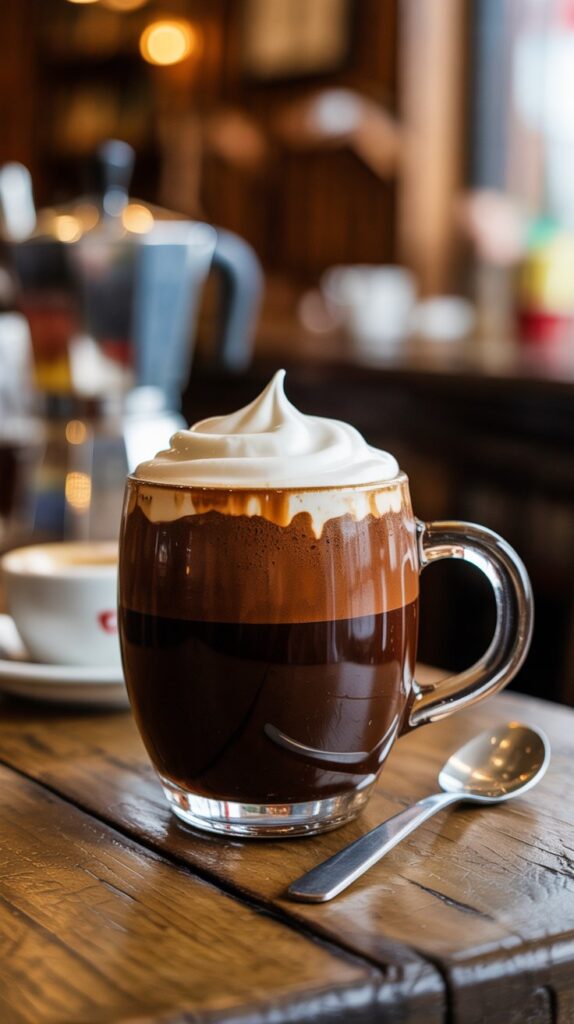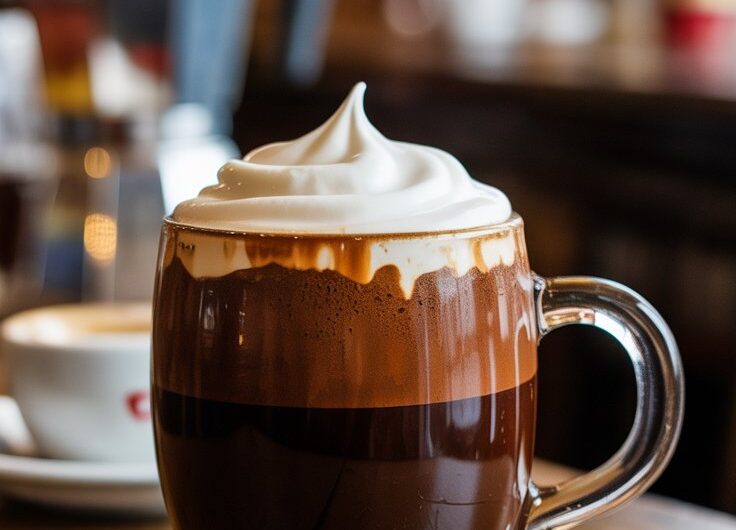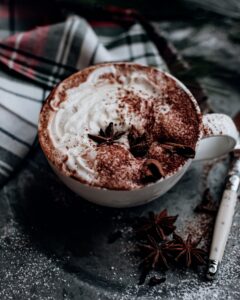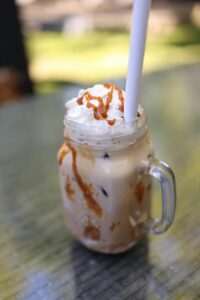Meet bicerin (bee-cheh-REEN), Italy’s answer to “why choose between coffee and dessert?”
Born in Turin, this stunning drink layers rich chocolate, bold espresso, and cool whipped cream in a single glass.
It looks fancy. It tastes like luxury. But here’s the secret: it’s incredibly easy to make at home.
Perfect for cozy mornings, date-night desserts, or impressing that one friend who “only drinks espresso.”
No fancy gear. No café prices. Just pure, velvety indulgence—layer by delicious layer.
What Is Bicerin?
Bicerin is a historic Italian drink that dates back to 18th-century Turin, where it was famously served at Caffè Al Bicerin—a café so iconic, it still stands today.
The name bicerin means “little glass” in Piedmontese, and that’s exactly how it’s traditionally served: in a small, clear glass that shows off its gorgeous layers.
It’s often mistaken for a mocha or a fancy latte, but don’t be fooled because this one’s in a league of its own.
A true bicerin is all about contrast: thick, velvety hot chocolate on the bottom, freshly brewed espresso floating on top, and a generous layer of whipped or lightly frothed cream to crown it.
There’s no stirring. No blending. Each sip moves from deep chocolate to bold coffee to silky cream, creating a rich, warming experience that feels more like a dessert than a drink.
It’s indulgent, elegant, and somehow still comforting, like the Italian version of a cozy blanket in a cup.
Ingredients You’ll Need
Here’s everything you’ll need to make a classic, café-style bicerin at home:
- 2 oz (60 ml) rich dark chocolate or ganache
This forms the base. Use a high-quality dark chocolate bar, ganache, or a thick European-style hot chocolate. The richer, the better. - 1 shot (1 oz / 30 ml) of espresso
The heart of the drink. Freshly brewed espresso adds that bold, slightly bitter contrast to balance the sweetness. - 2 oz (60 ml) heavy cream, lightly whipped or frothed
This is your creamy crown. Lightly whip or froth it just enough to float, but don’t overwhip or it won’t layer properly. - Optional: sugar
Add a little to the chocolate if you prefer a sweeter base. Traditional bicerin isn’t overly sweet, but you do you. - Optional: vanilla extract
A tiny splash in the cream adds warmth and depth. Think of it as the little black dress of flavor boosters. - Optional: shaved chocolate or cocoa powder (for garnish)
Adds a final touch of elegance, and let’s be honest, it just looks good on Instagram.
Equipment Checklist
No need for a full espresso bar—just a few basic tools will get the job done beautifully:
- Espresso maker (or Moka pot / AeroPress)
You’ll need a way to brew a strong shot of coffee. An espresso machine is ideal, but a Moka pot or AeroPress works great too. Go with what you have. - Saucepan or microwave-safe bowl (for melting chocolate)
This is for creating that rich, velvety chocolate base. Use low heat and stir often to avoid burning. - Milk frother or hand whisk (for cream)
A simple hand whisk, electric frother, or even a mason jar with a lid can get your cream just airy enough to float. - Heatproof glass (for layering)
A clear glass is essential to show off the drink’s signature layers. Bonus points if it’s pre-warmed to prevent cracking. - Spoon (for layering carefully)
Use the back of a spoon to gently float each layer. It’s the key to keeping the espresso and cream from crashing into the chocolate like a clumsy cannonball.
How to Make Bicerin at Home
Making bicerin at home might sound fancy, but it’s actually pretty simple when you break it down. All you need is a little patience, the right layering technique, and good ingredients.
Here’s how to build this cozy Italian classic.
1. Melt the Chocolate Base
Start by melting 2 oz (60 ml) of dark chocolate in a small saucepan or microwave-safe bowl. Add a splash of water, milk, or cream—just enough to loosen it into a pourable, thick sauce.
Stir until smooth and glossy. This is the foundation of your drink, so make it rich and dreamy.
2. Pour Chocolate into the Glass
Grab your heatproof glass and pour the melted chocolate into the bottom. Swirl it gently if you want a marbled look along the sides. Don’t rush, let it settle. This base is where the indulgence begins.
3. Brew and Layer the Espresso
Next, brew a single shot (1 oz / 30 ml) of espresso using your preferred method. Let it rest for a few seconds so it’s not boiling hot, which helps with layering.
Slowly pour it over the back of a spoon held just above the chocolate layer. This keeps the layers separate, not swirling together like a sad mocha.
4. Lightly Whip or Froth the Cream
Whip 2 oz (60 ml) of heavy cream until it’s thickened but still pourable—think soft peaks, not stiff. You can use a hand whisk, a frother, or even shake it in a jar. The goal is airy, not buttery.
5. Float the Cream on Top
Now, the magic moment: layer the cream. Again, use the back of a spoon to gently float the whipped cream on top of the espresso.
Don’t pour too fast or it’ll sink. You want a clear, cloud-like top layer that invites a spoonful.
6. Optional Garnish
Want to take it up a notch? Sprinkle grated chocolate, a dusting of cocoa powder, or even a pinch of cinnamon on top. It’s not traditional, but hey, your kitchen, your rules.
That’s it! Three layers. One glass. And a whole lot of “wow” with every sip.
Tips for Perfect Layering
Layering is what makes a bicerin so visually stunning and surprisingly satisfying to sip. The goal is a clean separation between the chocolate, espresso, and cream.
Here’s how to pull it off like a pro (even if it’s your first try).
Use the Back of a Spoon (Trust the Trick)
This is the secret weapon. Hold a spoon upside down just above the surface of the layer you’re pouring over. Then, slowly pour the next layer over the spoon’s back.
This softens the flow and prevents everything from crashing together.
Play with Temperature Contrast
Each layer should be at a slightly different temperature. Pour the warm chocolate first and let it sit for a few seconds. The espresso should be freshly brewed and hot but not scalding.
And the cream should be cool or just slightly chilled. This contrast helps the layers stay in their lanes instead of blending into one big brown puddle.
Use a Clear Glass
Presentation matters. A transparent heatproof glass lets you (and your guests) actually see the layers. That’s half the fun of bicerin. Skip the mug.
Go for a small tumbler, latte glass, or even a stemless wine glass if that’s what you have. The clearer, the better.
Flavor Variations to Try
Once you’ve mastered the classic bicerin, don’t be afraid to get creative. This drink is a perfect canvas for flavor experiments.
Hazelnut Bicerin
Nutella lovers, this one’s calling. Stir a spoonful of Nutella or a splash of hazelnut syrup into the melted chocolate layer for a smooth, nutty twist.
It’s like drinking a chocolate-hazelnut truffle, only better because there’s espresso involved.
Spiced Bicerin
Craving something with a little heat? Add a pinch of cinnamon, cardamom, or even a dash of chili powder to the chocolate while it melts.
These warm spices bring depth and a subtle kick that makes the drink feel extra cozy, especially on cold days. It’s like hugging your taste buds.
Boozy Bicerin
Want to turn your bicerin into a dessert-night showstopper? Add a splash of Baileys, Kahlúa, or Frangelico to the espresso or cream layer.
It’s rich, indulgent, and perfect for a slow weekend treat or a quiet night in.
Just remember: sip slowly because it sneaks up on you.
Vegan Bicerin
Dairy-free? No problem. Use dark chocolate, oat milk, or almond milk for the base, and top it with coconut whipped cream.
The layers still hold, the flavor stays indulgent, and no animals are involved. Win-win.
Cost Breakdown: Homemade vs Café
Let’s talk numbers because luxury doesn’t have to mean expensive. If you’re lucky enough to find bicerin at a specialty café, expect to pay around $6 to $8 per glass.
It’s considered a premium drink, and honestly, you’re mostly paying for the ambiance and presentation.
Now let’s break it down at home. Using quality ingredients like dark chocolate, espresso, and cream, your homemade version clocks in at just $1.50 to $2 per serving.
Even less if you already have most of the staples on hand. That’s over 70% in savings without skimping on flavor or style.
In short? You get a rich, café-worthy experience for a fraction of the price. Your wallet (and your taste buds) will thank you.
Final Words
Bicerin is rich, elegant, and surprisingly simple to make. It’s like sipping dessert without the fuss.
Try it on a slow Sunday morning or serve it as a show-off after-dinner treat. Either way, it’s a win!
FAQs
Can I use instant coffee instead of espresso?
Yes, but the flavor won’t be as intense, so use the strongest brew possible.
Can I make it dairy-free?
Absolutely! Use dark chocolate, plant milk, and coconut or oat cream.
Can I serve it cold?
Traditionally, no, but a chilled bicerin-style dessert drink is also delicious.
How do I keep the layers from mixing?
Pour slowly over a spoon and avoid stirring after building it.
Is this like a mocha?
Similar, but mochas are usually mixed and include milk; bicerin is layered and richer.
This Bicerin Coffee Recipe Will Make You Ditch Mochas Forever
Course: Coffee RecipesCuisine: ItalianDifficulty: Easy1
cup5
minutes5
minutes10
minutesA luxurious layered drink from Turin made with rich chocolate, bold espresso, and silky cream.
Ingredients
2 oz (60 ml) dark chocolate or thick hot chocolate
1 shot (1 oz / 30 ml) espresso
2 oz (60 ml) heavy cream, lightly whipped or frothed
Optional: sugar, vanilla extract, shaved chocolate (for garnish)
Directions
- Melt the chocolate with a splash of water or milk until smooth and thick.
- Pour the chocolate into the bottom of a heatproof glass.
- Brew espresso and gently layer it over the chocolate using the back of a spoon.
- Lightly whip or froth the cream until soft peaks form.
- Float the cream on top of the espresso using the spoon layering method.
- Garnish with shaved chocolate or cocoa powder, if desired.
Notes
- For vegan version: use dark chocolate, oat milk, and coconut cream.
- Use a clear glass for the best visual effect.
- Don’t stir, sip through the layers for full flavor.




